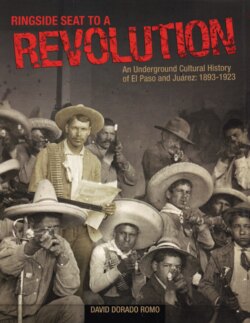Читать книгу Ringside Seat to a Revolution - David Dorado Romo - Страница 38
На сайте Литреса книга снята с продажи.
ОглавлениеNEWSPAPERS IN MEXICO, for the most part,
suppressed the news of the Tomóchic massacre.
When it made the front pages in El Paso, the Mexican
government tried to censor U.S. coverage of the mas-
sacre. Even though Victor L. Ochoa’s newspaper was
published on the American side of the line, pressure
by Mexican officials forced it to shut down.
“I was then the editor of a daily newspaper in El
Paso, Texas—El Hispano-Americano— whose circula-
tion was largely on Mexican soil,” Ochoa told the
New York Times:
I heard with horror of the massacre of my
friends and published the facts. The paper
was excluded from Mexico, and my con-
stituents forced to give it up. Merchants who
advertised in it were compelled by the
authorities to boycott me…The soldiers mas-
sacred the whole population…Imagine my
horror at this. My own family had fallen vic-
tims to the relentless cruelty of the [Díaz gov-
ernment]. This, too, I published. My paper
soon succumbed for its lack of support. I
gathered all I had, and, turning all my effects
into cash, threw the money into the fund for
my people’s liberation.59
Ochoa’s newspaper wasn’t the only local publi-
cation that was banned from Mexico. The El Paso
Times, under the editorial direction of Juan Hart, was
also prohibited from crossing south of the border
after it published a manifesto put out by an armed
group of revolutionists that, according to the newspa-
per, was led by several Tomóchic survivors.60 They
had attacked the border customhouse in Palomas,
Chihuahua on November 1893, shouting “Remember
Tomóchic!”61 The Mexican government tried to por-
tray them as just a bunch of ruffians and bandits. But
the revolutionary document that the El Paso Times
published showed that the raiders in fact did have a
political agenda.
The rebel manifesto was very similar to the Plan
de Tomóchic. It too condemned the Mexican presi-
dent for the Tomóchic massacre, the suppression of a
free press and the imprisonment of writers who criti-
cized the government. It called for the principle of no
reelection, which would prohibit future Mexican pres-
idents from serving more than one term.62 It also
denounced the economic concessions the govern-
ment of Porfirio Díaz made to U.S. capitalists. Díaz,
the manifesto proclaimed, had “mortgaged Mexico on
the foreign market. His mode of selling his country to
foreigners is criminally censurable.”63
In retaliation for publishing articles sympathetic
to the rebels, the Mexican government threatened to
imprison any Mexican businessman who advertised
in either El Hispano-Americano or the El Paso Times.
One pro-Díaz newspaper in Mexico City was upset at
the amount of coverage the fronterizo newspapers
gave the insurrection along the U.S.-Mexico border.
“Not only the [El Paso] Times, but the other opposi-
tion papers, are at present printing more Mexican
news, via the United States, than ever before in their
history,” Las Dos Repúblicas complained.64 The gov-
ernment of Porfirio Díaz claimed these publications
were fanning the flames of revolution. The govern-
ment was right.
IN THE WINTER of 1893, Victor Ochoa became
the first Mexican American to launch a revolutionary
movement from El Paso. He was ahead of his time in
more ways than one.
Even the name of his newspaper, El Hispano-
Americano, had a modern ring to it. The term
Hispano Americano, or Hispanic American, was
rarely used by fronterizos around the turn of the cen-
tury.65 El Pasoans with Mexican ancestry, even those
born in the United States, were usually just called
33
VICTOR L. OCHOA: EL PASO’S FIRST REVOLUTIONIST
59
New York Times, August 17, 1895.
60
This was probably inaccurate. Most historical accounts don’t mention any survivors of the Tomóchic massacre.
61
“Revolution! Los Tomochics Attack the Custom House at Palomas,” El Paso Times, November 10, 1893; El Paso Times, November 9, 1893.
The revolutionists captured 800 pounds of ammunition, carbines, arms, supplies as well as $300 cash.
62
El Paso Times, December 3, 1893.
63
Ibid.
64
El Paso Times, December 21, 1893.
65
The term “Hispanic American” was, however, gaining some acceptance during the 1890s among some fronterizos. The Alianza Hispano-American
was founded in 1894 and there was also a Congreso Literario Hispanoamericano in 1892 to commemorate the “discovery” of the Americas.
